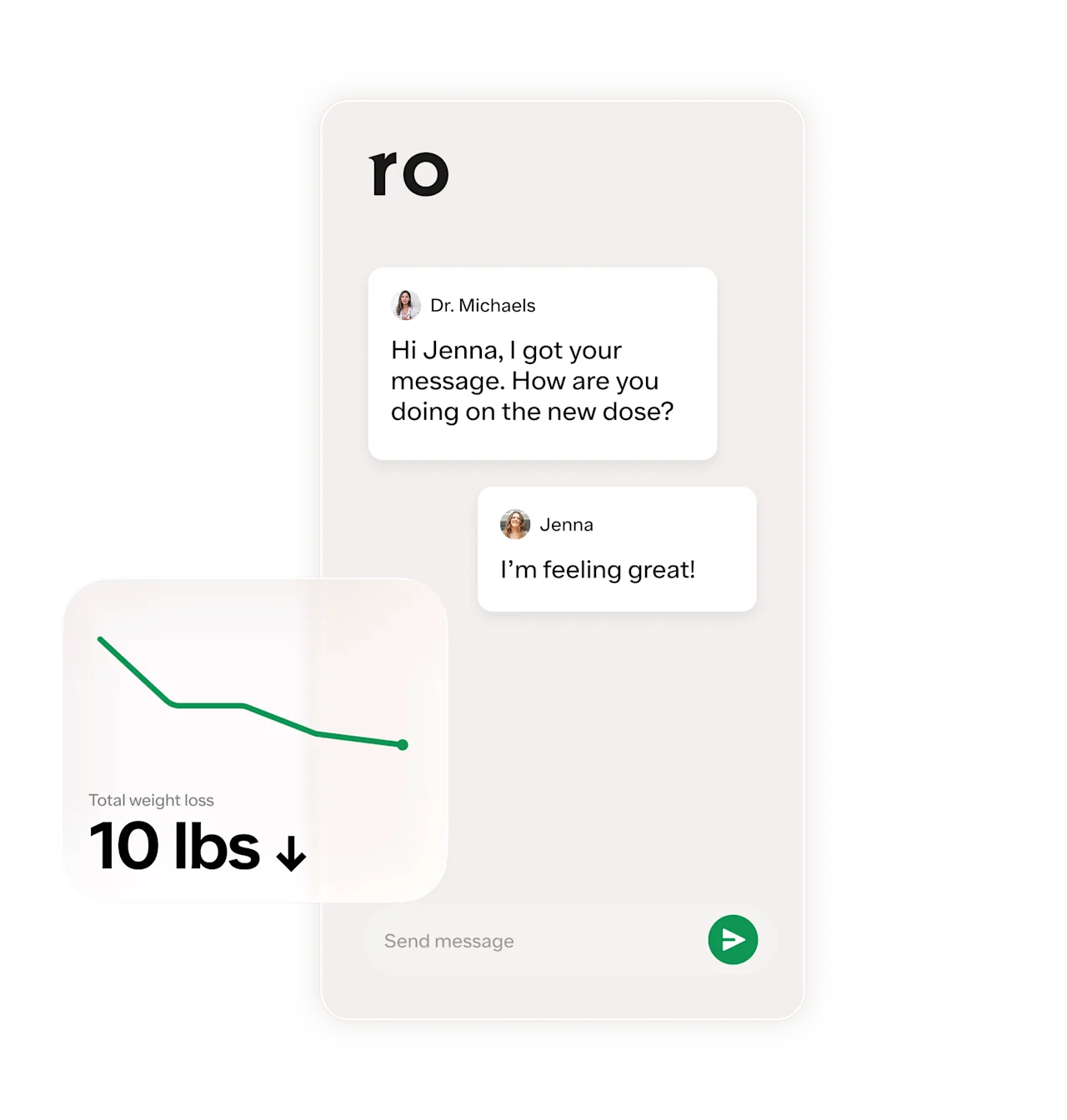*Patients with diabetes but with a BMI of ≥30, or ≥27 with comorbidities, lost an average of 7% of their body weight in 1 year in a 68-week clinical trial evaluating 1 mg semaglutide, when combined with a reduced-calorie diet and increased physical activity.
Join 1,000,000+ Ro weight loss patients
Ozempic® prescribed online for weight loss
(semaglutide) injection
A weekly shot to lose weight
Helps you feel full faster, longer
Improves the way your body responds to sugars
Ozempic is not FDA-approved for weight loss, but may be prescribed if a provider deems it appropriate
$45 for your first month
Safety info: Ozempic treats type 2 diabetes but may be prescribed off-label for weight loss, if appropriate. Ozempic may have serious side effects, including possible thyroid tumors. Do not use if you or your family have a history of a type of thyroid cancer called MTC or MEN 2. Read more about serious warnings and safety info.
$45 to get started, then $145/month for ongoing care. Cost of medication not included.

Revolutionary medication
Ozempic is semaglutide (a GLP-1) that may be prescribed for weight loss, if appropriate. It’s a once-weekly shot that works by mimicking your body’s natural hormones, helping you feel fuller faster and for longer.
Medication is not included in the cost of the Body Program. But don’t worry, our insurance concierge partners explore all options to help get you covered. Ozempic is FDA-approved for type 2 diabetes treatment, but may be prescribed for weight loss.
Ozempic
semaglutide
In Ozempic clinical trials, patients lost an average of 7% of their body weight*
"Is using medication to lose weight cheating?"
Dr. Steve Silvestro, Ro
Which GLP-1 is right for you?
Semaglutide injection was first approved under the brand name Ozempic in 2017 as a treatment for type 2 diabetes. In 2021, the FDA approved the drug at a different dosage under the brand name Wegovy as a weight loss medication. Doctors often, using their medical judgment and discretion, prescribe both for weight loss. Liraglutide injection was FDA approved for weight loss in 2014 under the brand name Saxenda.
All three medications are GLP-1s, but there are some key differences between them.
*Patients with diabetes but with a BMI of ≥30, or ≥27 with comorbidities, lost an average of 7% of their body weight in 1 year in a 68-week clinical trial evaluating 1 mg semaglutide, when combined with a reduced-calorie diet and increased physical activity.
Meet the Ro Ambassadors who inspired the Body Program
Lost 40 lbs in 11 months
“I have never felt better. I have never had more energy. This medication changed my life.”
Lost 30 lbs in 1 year
“I started losing weight almost immediately. To me, truly, this has been a game-changer.”


Our insurance concierge partners will work to find you coverage for medication.
Here's how they'll do it:
Liaise with your insurance
We know this can be a headache, so the team will take care of communicating with your insurance company. They’ll even handle the paperwork.
Explore every option
The team will look into the medication options that are right for you. If you get denied for one medication, they’ll look for other options that are clinically appropriate for you. And, once approved, the team will send your prescription to your preferred pharmacy.
Find solutions to get you started
If your insurance doesn’t cover the cost of your medication, the team will see if there are patient access programs that would help reduce your out-of-pocket cost. If you want to explore cash pay options, they’ll help you figure out the available options in your area.
Thousands of people are losing weight with GLP-1 medications
Hear from real Ro members who are hitting their weight loss goals through the Ro Body membership. Ro members taking branded GLP-1 medications were paid for their testimonials.
“I’ve had some pretty amazing success. I’m down 15 pounds and I couldn’t be happier."
Sonia, Ro Member
“It's really helping handle my cravings better, which is what I really like about this program."
James, Ro Member
“It was like a switch once I started the medication, I just wasn’t so obsessed with food.”
Chaleeta, Ro Member
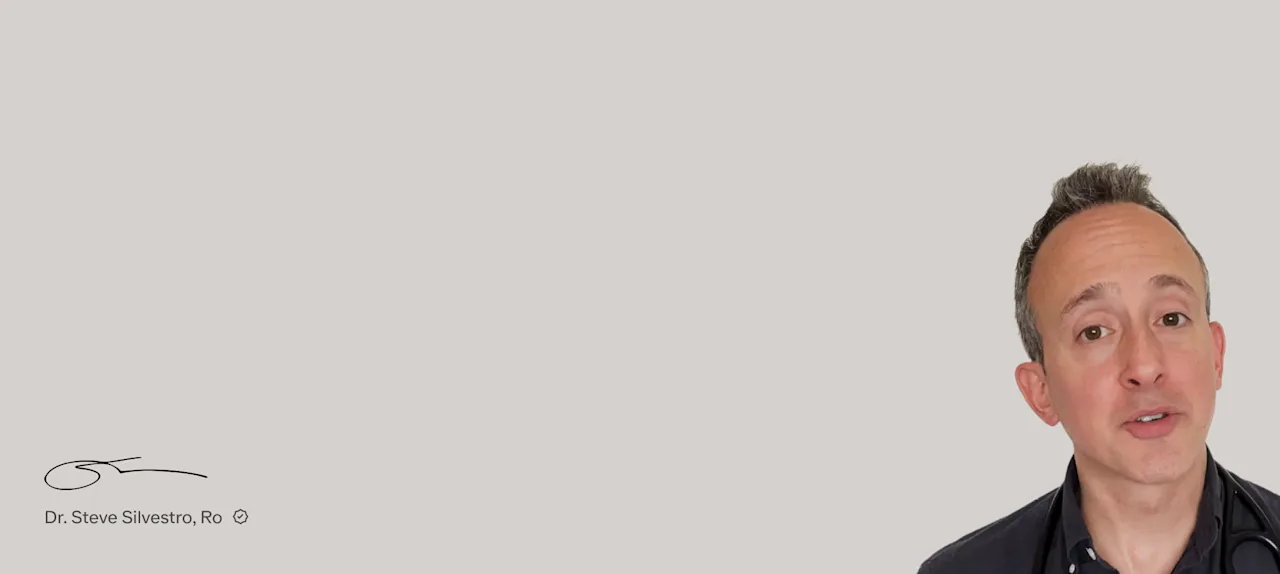
Ozempic 101
What is Ozempic?
Ozempic is a brand-name version of the generic medication semaglutide, which is a type of medication called a glucagon-like peptide 1 receptor agonist. Instead of that tongue-twister of a name, we call these medications “GLP-1s” for short.
Ozempic is FDA-approved for the management of certain symptoms and risks of type 2 diabetes.
How does Ozempic work?
Ozempic works by slowing the digestion process, which can help you to feel full for longer. Ozempic, like other GLP-1 receptor agonists, acts like a hormone your body naturally makes to regulate blood sugar and may help support weight loss.
Do you prescribe Ozempic for weight loss?
Ozempic is not FDA-approved for weight loss. Ro-affiliated healthcare professionals have the discretion to prescribe a medication off-label if they believe it is an appropriate course of treatment for a particular patient.
How can Ozempic help with weight loss? It acts like a natural hormone your body uses to regulate blood sugar and appetite—key steps in resetting your biological set point to help you maintain a new, lower weight.
See if Ozempic is right for you here.
What is Ozempic’s dosing?
Ozempic dosing starts out low, then gradually increases over the first few months until a steady dose is reached. If prescribed, your Ro-affiliated provider will work with you to find the schedule and dosing that’s right for you. As an example, the lowest dose of Ozempic is 0.25 mg once a week and the maximum dose is 2.0 mg once a week.
How do you take Ozempic?
Ozempic comes in a prefilled injection pen that contains multiple doses. If prescribed, you (or someone in your household) will select the prescribed dose, then administer the injection under the skin of your stomach, thigh, or arm once a week.
While a routine injection may sound intimidating, the Ozempic pen uses a tiny needle designed to minimize discomfort. You’ll also receive clear instructions on using the injection pen, and your Ro-affiliated provider can offer additional advice.
Will my insurance cover the cost of Ozempic?
The cost of your Ozempic medication can range depending on your insurance coverage—and we’re here to help with that!
Ro’s insurance concierge will work with your insurance provider to help with the process of determining coverage for your GLP-1 medication, which is paid for separately from your Ro Body membership. Ro does not accept insurance for the Ro Body membership, which is cash pay only and does not accept insurance.
Currently, Ro can’t help coordinate coverage for GLP-1 medications for government insurance plans — but depending on your plan, you may still be able to pay out of pocket for certain cash-pay medication options. If you have Federal Employee Health Benefits Program (FEHB), you can join the Ro Body membership and access our insurance concierge.
Your timeline to treatment
From personalized treatment to insurance support, we help you get—and stay—on track.
Start losing weight in 5 simple steps
1. Start your online visit
Answer a few questions about your health and goals, all online—no in-person doctor’s office visit necessary. You’ll find out if you’re eligible within 2 days.
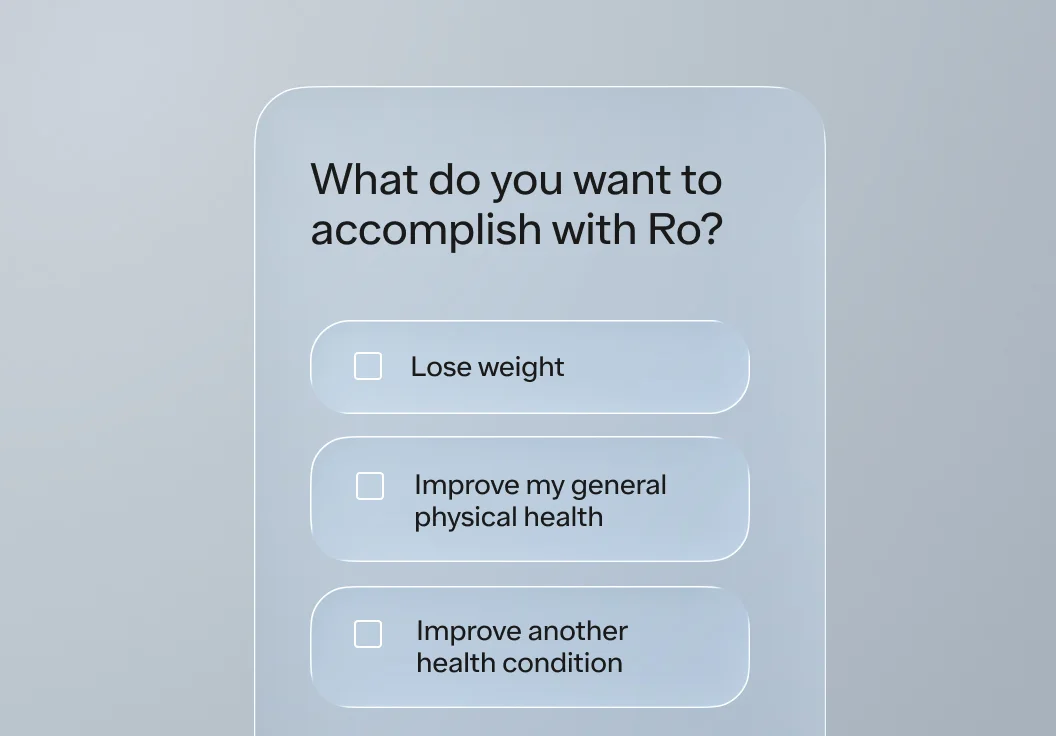
2. Provider writes an Rx (if appropriate)
A provider will review your info and prescribe the right GLP-1 treatment for you, if eligible. Get ready for your first dose in two weeks if using insurance, or less than a week if paying cash.
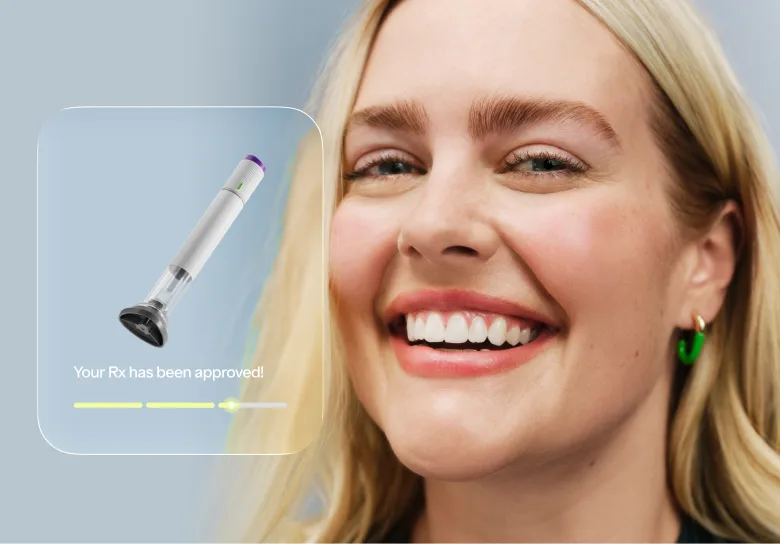
3. Check your insurance coverage
Ro navigates insurance on your behalf to see if coverage is available for your GLP-1s. If using insurance, Ro's insurance concierge submits all paperwork on your behalf. If you're covered, a prescription is sent to your pharmacy. If not, Ro will fight for your coverage or provide the alternative GLP-1 options right for you. This process takes about 2-3 weeks.

4. Start your treatment
If prescribed, your medication ships right to your door or can be picked up at your pharmacy. Once prescribed, you could take your first shot in less than a week.

5. Get support to stay on track
Keep making progress with regular check-ins, expert guidance, and access to your care team 24/7. Ongoing care and support is there for you when you need it—whether it’s a quick chat with your provider or routine check-ins, we’re with you every step of the way.
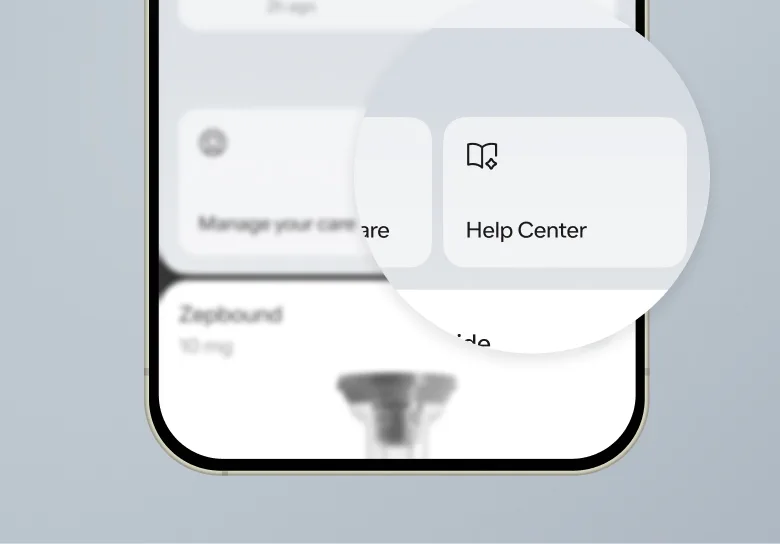
Questions we hear every day
How much does Ozempic cost?
The cost of your Ozempic medication can range depending on your insurance coverage—and we’re here to help with that!
Ro’s insurance concierge will work with your insurance provider to determine coverage for your GLP-1 medication. Please note that this medication is paid for separately from your Ro Body membership, which is only available by cash pay only and does not accept insurance.
Currently, Ro can’t help coordinate coverage for GLP-1 medications for government insurance plans — but depending on your plan, you may still be able to pay out of pocket for certain cash-pay medication options. If you have Federal Employee Health Benefits Program (FEHB), you can join the Ro Body membership and access our insurance concierge.
Are there foods to avoid while taking Ozempic?
While a Ro-affiliated provider may offer personalized guidance for each individual, in general, there are no foods to avoid while taking Ozempic. In fact, our Body Program makes a point to avoid labeling any food as “off-limits,” and instead guides you in finding an approach to food that’s both enjoyable and supports your weight loss goals.
However, if prescribed Ozempic, you might choose to avoid certain foods on days that your doses are increased. Some gastrointestinal side effects like nausea may occur when Ozempic doses are increased, so you might find that it’s best to avoid foods that make you feel gassy or bloated on days that you’re increasing your dose.
What are the most common Ozempic side effects?
All medications carry a risk of potential side effects. Ozempic’s side effects are typically mild and often improve within the first few weeks of treatment. When they occur, it’s usually when doses are increased, then tend to improve once a steady dose is reached. Some of the most common side effects include:
Nausea
Vomiting
Upset stomach
Stomach pains
Constipation
Diarrhea
Heartburn
Acid reflux
Belching and gas
Dizziness
Headaches
Fatigue
More severe side effects are rarer but possible. Serious side effects include:
Thyroid cancer—The FDA has issued its most serious warning (called a BOXED WARNING) that GLP-1s may be associated with a type of thyroid cancer called medullary thyroid carcinoma. So far, this side effect has primarily been seen in laboratory studies using rodents, so the risk to humans has not been determined.
Pancreatitis
Gallbladder disease
Rapid heartbeat
Severe allergy (hypersensitivity)
Low blood sugar
Vision problems (diabetic retinopathy)
Kidney disease
Suicidal thoughts or behaviors
Please see the full Prescribing Information, including the BOXED WARNING, for complete safety information.
How much does metabolic testing cost?
If your provider orders a metabolic health test, testing at any Quest location is included in the cost of the Ro Body membership. Or you can purchase an at-home blood collection kit through Ro for $75.
If you live in a state where Quest is not available, we’ll automatically send you an at-home collection kit for no charge.
How do I schedule a video call with my provider?
It's simple — just send a message in your provider chat requesting a video call, and your provider will send you a link to schedule a video visit.
Important safety information
What you should know before taking Ozempic.


